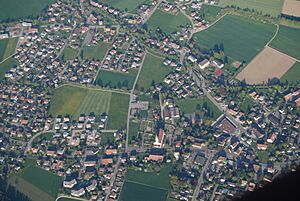Kriegstetten facts for kids
Quick facts for kids
Kriegstetten
|
||
|---|---|---|
|
||
| Country | Switzerland | |
| Canton | Solothurn | |
| District | Wasseramt | |
| Area | ||
| • Total | 1.14 km2 (0.44 sq mi) | |
| Elevation | 453 m (1,486 ft) | |
| Population
(Dec 2020 )
|
||
| • Total | 1,292 | |
| • Density | 1,133/km2 (2,935/sq mi) | |
| Postal code |
4566
|
|
| Surrounded by | Derendingen, Gerlafingen, Halten, Obergerlafingen, Oekingen, Recherswil | |
Kriegstetten is a small town, also called a municipality, in Switzerland. It is located in the Wasseramt district within the canton of Solothurn.
Contents
Discovering Kriegstetten's Past
Kriegstetten is an old settlement with a long history. It was first mentioned in official records way back in 1256. Back then, its name was written as Krechsteiten or Kriechsteiten.
Exploring Kriegstetten's Geography
Kriegstetten covers an area of about 1.14 square kilometers (0.44 square miles). This is roughly the size of 160 football fields!
How Land is Used in Kriegstetten
A big part of Kriegstetten's land, about 43.9%, is used for farming. Forests cover about 8.8% of the area. The rest, about 46.5%, is where buildings and roads are located.
The town is the main center of the Wasseramt district. You can find it on the eastern edge of the Gerlafinger plain.
Understanding Kriegstetten's Coat of Arms
A coat of arms is like a special symbol or logo for a town or family. Kriegstetten's coat of arms is yellow (Or). It features three green (Vert) linden leaves with stems (slipped).
Kriegstetten's Population and People
Kriegstetten has a population of 1,292 people. About 7.6% of the people living here are from other countries.
Languages Spoken in Kriegstetten
Most people in Kriegstetten speak German. In 2000, about 95.6% of the residents spoke German. A smaller number of people also speak Italian or French.
Age Groups in Kriegstetten
In 2000, here's how the population was divided by age:
- About 6.8% were young children (0-6 years old).
- About 20.1% were teenagers (7-19 years old).
- About 4.5% were young adults (20-24 years old).
- About 32.9% were adults (25-44 years old).
- About 24.7% were older adults (45-64 years old).
- About 8.1% were seniors (65-79 years old).
- About 2.9% were over 80 years old.
Historical Population Growth
The chart below shows how Kriegstetten's population has changed over time:

Kriegstetten's Economy and Jobs
In 2010, the unemployment rate in Kriegstetten was 3.6%. This means a small number of people who wanted jobs couldn't find them.
Types of Jobs in Kriegstetten
Many people in Kriegstetten work in different areas:
- Some work in the primary sector, like farming.
- Others work in the secondary sector, which includes making things (manufacturing) and building.
- The largest number of jobs are in the tertiary sector, also known as the service sector. This includes jobs in stores, transportation, hotels, restaurants, education, and healthcare.
Commuting to Work
Many people who live in Kriegstetten travel to other towns for work. Also, some people come from other towns to work in Kriegstetten. Most people use a private car to get to work, while some use public transportation.
Religion in Kriegstetten
Based on the 2000 census, here's a look at the religious groups in Kriegstetten:
- About 32.3% of the population were Roman Catholic.
- About 41.9% belonged to the Swiss Reformed Church.
- Smaller groups included Orthodox Christians, Christian Catholics, and other Christian churches.
- About 1.15% of the population were Islamic.
- There were also a few Buddhists and Hindus.
- About 16.43% of the people did not belong to any church or identified as agnostic or atheist.
Education in Kriegstetten
Many adults in Kriegstetten have completed a good level of education. About 43.5% have finished upper secondary education, which is like high school. About 13.4% have gone on to higher education, such as university or a specialized college (Fachhochschule).
Some students who live in Kriegstetten go to schools in other towns. Also, students from other towns come to study in Kriegstetten.
See also
 In Spanish: Kriegstetten para niños
In Spanish: Kriegstetten para niños






